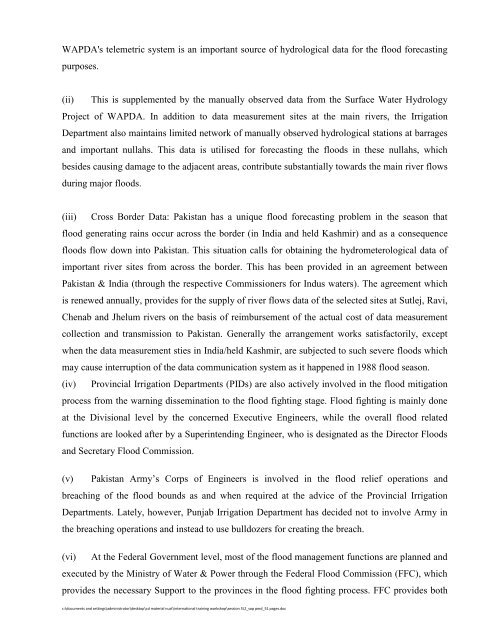SOP for Flood Forecasting & Early Warning - UNESCO Islamabad
SOP for Flood Forecasting & Early Warning - UNESCO Islamabad
SOP for Flood Forecasting & Early Warning - UNESCO Islamabad
Create successful ePaper yourself
Turn your PDF publications into a flip-book with our unique Google optimized e-Paper software.
WAPDA's telemetric system is an important source of hydrological data <strong>for</strong> the flood <strong>for</strong>ecasting<br />
purposes.<br />
(ii) This is supplemented by the manually observed data from the Surface Water Hydrology<br />
Project of WAPDA. In addition to data measurement sites at the main rivers, the Irrigation<br />
Department also maintains limited network of manually observed hydrological stations at barrages<br />
and important nullahs. This data is utilised <strong>for</strong> <strong>for</strong>ecasting the floods in these nullahs, which<br />
besides causing damage to the adjacent areas, contribute substantially towards the main river flows<br />
during major floods.<br />
(iii) Cross Border Data: Pakistan has a unique flood <strong>for</strong>ecasting problem in the season that<br />
flood generating rains occur across the border (in India and held Kashmir) and as a consequence<br />
floods flow down into Pakistan. This situation calls <strong>for</strong> obtaining the hydrometerological data of<br />
important river sites from across the border. This has been provided in an agreement between<br />
Pakistan & India (through the respective Commissioners <strong>for</strong> Indus waters). The agreement which<br />
is renewed annually, provides <strong>for</strong> the supply of river flows data of the selected sites at Sutlej, Ravi,<br />
Chenab and Jhelum rivers on the basis of reimbursement of the actual cost of data measurement<br />
collection and transmission to Pakistan. Generally the arrangement works satisfactorily, except<br />
when the data measurement sties in India/held Kashmir, are subjected to such severe floods which<br />
may cause interruption of the data communication system as it happened in 1988 flood season.<br />
(iv) Provincial Irrigation Departments (PIDs) are also actively involved in the flood mitigation<br />
process from the warning dissemination to the flood fighting stage. <strong>Flood</strong> fighting is mainly done<br />
at the Divisional level by the concerned Executive Engineers, while the overall flood related<br />
functions are looked after by a Superintending Engineer, who is designated as the Director <strong>Flood</strong>s<br />
and Secretary <strong>Flood</strong> Commission.<br />
(v) Pakistan Army’s Corps of Engineers is involved in the flood relief operations and<br />
breaching of the flood bounds as and when required at the advice of the Provincial Irrigation<br />
Departments. Lately, however, Punjab Irrigation Department has decided not to involve Army in<br />
the breaching operations and instead to use bulldozers <strong>for</strong> creating the breach.<br />
(vi) At the Federal Government level, most of the flood management functions are planned and<br />
executed by the Ministry of Water & Power through the Federal <strong>Flood</strong> Commission (FFC), which<br />
provides the necessary Support to the provinces in the flood fighting process. FFC provides both<br />
c:\documents and settings\administrator\desktop\cd material nust\international training workshop\session 5\2_sop pmd_51 pages.doc

















